The Cambridge History of Japan, Vol. 4: Early Modern Japan
Подождите немного. Документ загружается.

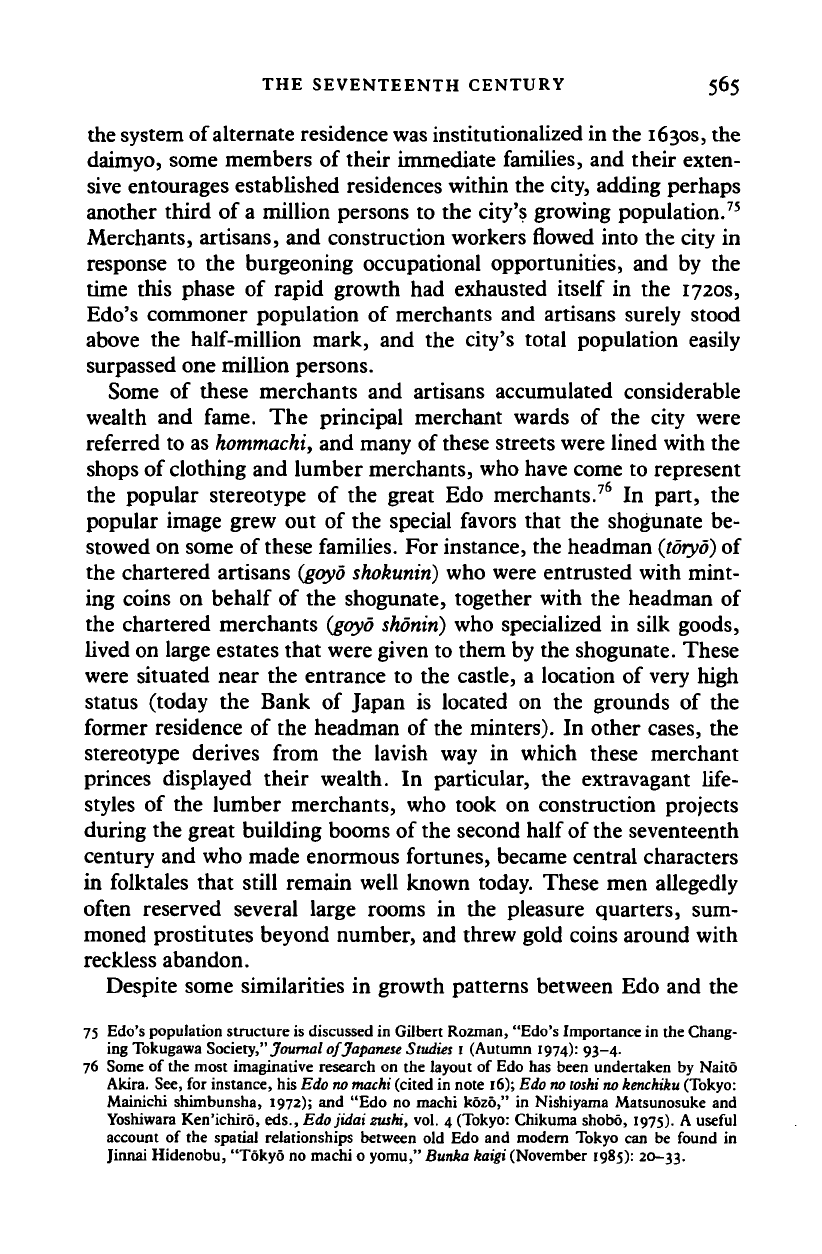
THE SEVENTEENTH CENTURY 565
the system of alternate residence
was
institutionalized in the 1630s, the
daimyo, some members of their immediate families, and their exten-
sive entourages established residences within the city, adding perhaps
another third of a million persons to the city's growing population.
75
Merchants, artisans, and construction workers flowed into the city in
response to the burgeoning occupational opportunities, and by the
time this phase of rapid growth had exhausted itself in the 1720s,
Edo's commoner population of merchants and artisans surely stood
above the half-million mark, and the city's total population easily
surpassed one million persons.
Some of these merchants and artisans accumulated considerable
wealth and fame. The principal merchant wards of the city were
referred to as
hommachi,
and many of
these
streets were lined with the
shops of clothing and lumber merchants, who have come to represent
the popular stereotype of the great Edo merchants.
76
In part, the
popular image grew out of the special favors that the shogunate be-
stowed on some of these families. For instance, the headman
(toryo)
of
the chartered artisans
(goyo shokunin)
who were entrusted with mint-
ing coins on behalf of the shogunate, together with the headman of
the chartered merchants
(goyo shonin)
who specialized in silk goods,
lived on large estates that were given to them by the shogunate. These
were situated near the entrance to the castle, a location of very high
status (today the Bank of Japan is located on the grounds of the
former residence of the headman of the minters). In other cases, the
stereotype derives from the lavish way in which these merchant
princes displayed their wealth. In particular, the extravagant life-
styles of the lumber merchants, who took on construction projects
during the great building booms of the second half of the seventeenth
century and who made enormous fortunes, became central characters
in folktales that still remain well known today. These men allegedly
often reserved several large rooms in the pleasure quarters, sum-
moned prostitutes beyond number, and threw gold coins around with
reckless abandon.
Despite some similarities in growth patterns between Edo and the
75 Edo's population structure is discussed in Gilbert Rozman, "Edo's Importance in the Chang-
ing Tokugawa
Society,"
Journal of Japanese Studies i (Autumn 1974): 93-4.
76 Some of the most imaginative research on the layout of Edo has been undertaken by Naito
Akira. See, for instance, his Edo
no machi
(cited in note 16); Edo
no loshi no kenchiku
(Tokyo:
Mainichi shimbunsha, 1972); and "Edo no machi kozo," in Nishiyama Matsunosuke and
Yoshiwara Ken'ichiro, eds., Edojidai zushi, vol. 4 (Tokyo: Chikuma shobo, 1975). A useful
account of the spatial relationships between old Edo and modern Tokyo can be found in
Jinnai Hidenobu, "Tokyo no machi o yomu," Bunka kaigi (November 1985): 20-33.
Cambridge Histories Online © Cambridge University Press, 2008
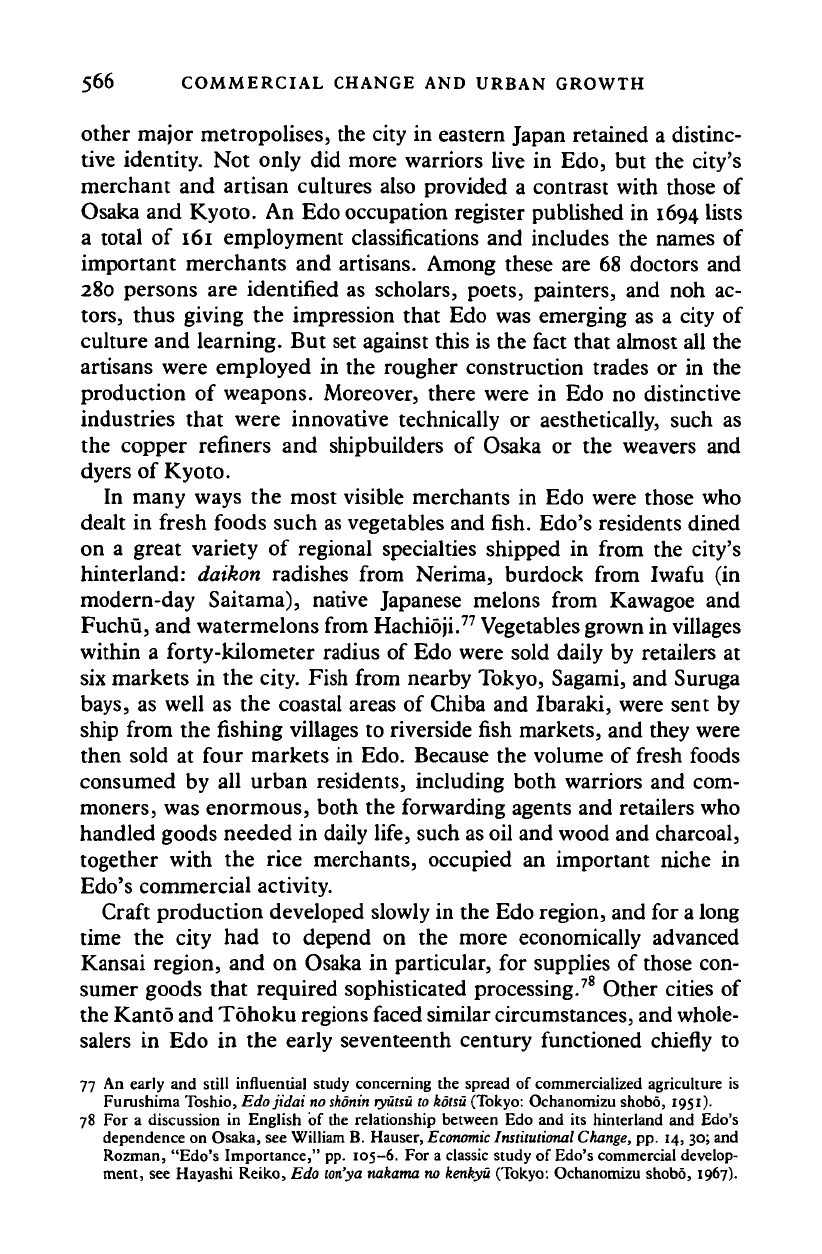
566 COMMERCIAL CHANGE AND URBAN GROWTH
other major metropolises, the city in eastern Japan retained a distinc-
tive identity. Not only did more warriors live in Edo, but the city's
merchant and artisan cultures also provided a contrast with those of
Osaka and Kyoto. An Edo occupation register published in 1694 lists
a total of 161 employment classifications and includes the names of
important merchants and artisans. Among these are 68 doctors and
280 persons are identified as scholars, poets, painters, and noh ac-
tors,
thus giving the impression that Edo was emerging as a city of
culture and learning. But set against this is the fact that almost all the
artisans were employed in the rougher construction trades or in the
production of weapons. Moreover, there were in Edo no distinctive
industries that were innovative technically or aesthetically, such as
the copper refiners and shipbuilders of Osaka or the weavers and
dyers of Kyoto.
In many ways the most visible merchants in Edo were those who
dealt in fresh foods such as vegetables and fish. Edo's residents dined
on a great variety of regional specialties shipped in from the city's
hinterland: daikon radishes from Nerima, burdock from Iwafu (in
modern-day Saitama), native Japanese melons from Kawagoe and
Fuchu, and watermelons from Hachioji.
77
Vegetables grown in villages
within a forty-kilometer radius of Edo were sold daily by retailers at
six markets in the city. Fish from nearby Tokyo, Sagami, and Suruga
bays,
as well as the coastal areas of Chiba and Ibaraki, were sent by
ship from the fishing villages to riverside fish markets, and they were
then sold at four markets in Edo. Because the volume of fresh foods
consumed by all urban residents, including both warriors and com-
moners, was enormous, both the forwarding agents and retailers who
handled goods needed in daily life, such as oil and wood and charcoal,
together with the rice merchants, occupied an important niche in
Edo's commercial activity.
Craft production developed slowly in the Edo region, and for a long
time the city had to depend on the more economically advanced
Kansai region, and on Osaka in particular, for supplies of those con-
sumer goods that required sophisticated processing.
78
Other cities of
the Kanto and Tohoku regions faced similar circumstances, and whole-
salers in Edo in the early seventeenth century functioned chiefly to
77 An early and still influential study concerning the spread of commercialized agriculture is
Furushima Toshio, Edojidai no
shonin ryutsu
to
kotsu
(Tokyo: Ochanomizu shobo, 1951).
78 For a discussion in English of the relationship between Edo and its hinterland and Edo's
dependence on Osaka, see William B. Hauser,
Economic
Institutional
Change,
pp. 14, 30; and
Rozman, "Edo's Importance," pp. 105-6. For a classic study of Edo's commercial develop-
ment, see Hayashi Reiko, Edo ton'ya nakama no kenkyu (Tokyo: Ochanomizu shobo, 1967).
Cambridge Histories Online © Cambridge University Press, 2008
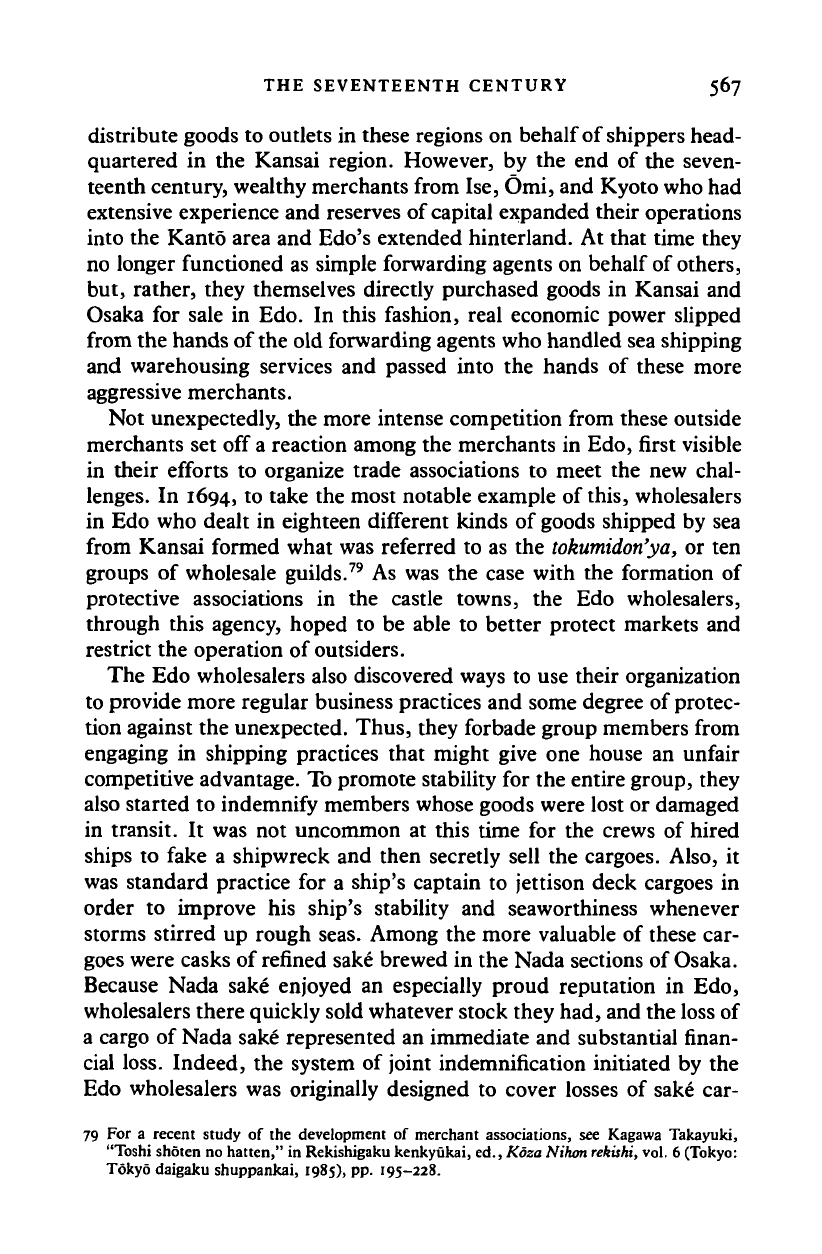
THE SEVENTEENTH CENTURY 567
distribute goods to outlets in these regions on behalf of shippers head-
quartered in the Kansai region. However, by the end of the seven-
teenth century, wealthy merchants from Ise, Omi, and Kyoto who had
extensive experience and reserves of capital expanded their operations
into the Kanto area and Edo's extended hinterland. At that time they
no longer functioned as simple forwarding agents on behalf of others,
but, rather, they themselves directly purchased goods in Kansai and
Osaka for sale in Edo. In this fashion, real economic power slipped
from the hands of the old forwarding agents who handled sea shipping
and warehousing services and passed into the hands of these more
aggressive merchants.
Not unexpectedly, the more intense competition from these outside
merchants set off
a
reaction among the merchants in Edo, first visible
in their efforts to organize trade associations to meet the new chal-
lenges. In 1694, to take the most notable example of
this,
wholesalers
in Edo who dealt in eighteen different kinds of goods shipped by sea
from Kansai formed what was referred to as the
tokumidon'ya,
or ten
groups of wholesale guilds.
79
As was the case with the formation of
protective associations in the castle towns, the Edo wholesalers,
through this agency, hoped to be able to better protect markets and
restrict the operation of outsiders.
The Edo wholesalers also discovered ways to use their organization
to provide more regular business practices and some degree of protec-
tion against the unexpected. Thus, they forbade group members from
engaging in shipping practices that might give one house an unfair
competitive advantage. To promote stability for the entire group, they
also started to indemnify members whose goods were lost or damaged
in transit. It was not uncommon at this time for the crews of hired
ships to fake a shipwreck and then secretly sell the cargoes. Also, it
was standard practice for a ship's captain to jettison deck cargoes in
order to improve his ship's stability and seaworthiness whenever
storms stirred up rough seas. Among the more valuable of these car-
goes were casks of refined sake brewed in the Nada sections of Osaka.
Because Nada sake enjoyed an especially proud reputation in Edo,
wholesalers there quickly sold whatever stock they had, and the loss of
a cargo of Nada sake represented an immediate and substantial finan-
cial loss. Indeed, the system of joint indemnification initiated by the
Edo wholesalers was originally designed to cover losses of sake car-
79 For a recent study of the development of merchant associations, see Kagawa Takayuki,
"Toshi shoten no hatten," in Rekishigaku kenkyukai, ed., Koza Nihon
rekishi,
vol. 6 (Tokyo:
Tokyo daigaku shuppankai, 1985), pp. 195-228.
Cambridge Histories Online © Cambridge University Press, 2008
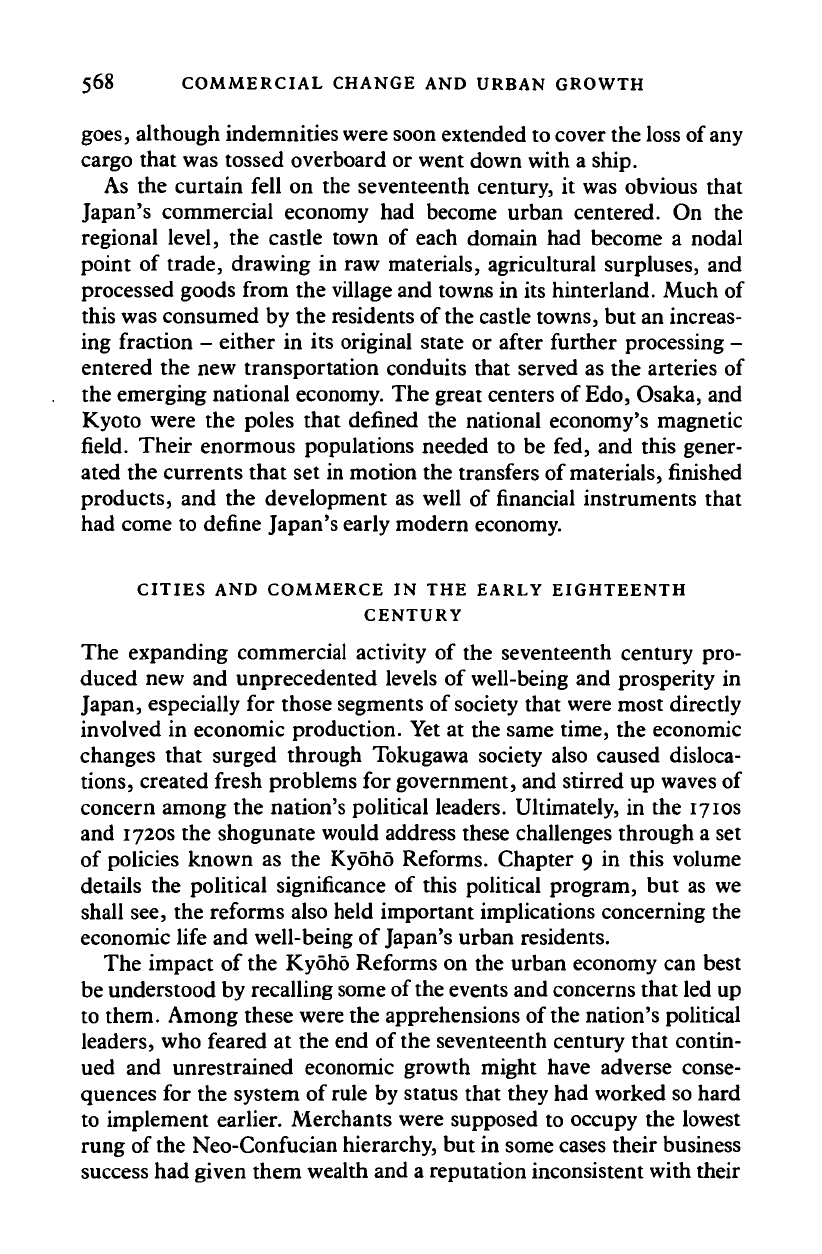
568 COMMERCIAL CHANGE AND URBAN GROWTH
goes,
although indemnities were soon extended to cover the loss of any
cargo that was tossed overboard or went down with a ship.
As the curtain fell on the seventeenth century, it was obvious that
Japan's commercial economy had become urban centered. On the
regional level, the castle town of each domain had become a nodal
point of trade, drawing in raw materials, agricultural surpluses, and
processed goods from the village and towns in its hinterland. Much of
this was consumed by the residents of the castle towns, but an increas-
ing fraction - either in its original state or after further processing -
entered the new transportation conduits that served as the arteries of
the emerging national economy. The great centers of
Edo,
Osaka, and
Kyoto were the poles that defined the national economy's magnetic
field. Their enormous populations needed to be fed, and this gener-
ated the currents that set in motion the transfers of materials, finished
products, and the development as well of financial instruments that
had come to define Japan's early modern economy.
CITIES AND COMMERCE IN THE EARLY EIGHTEENTH
CENTURY
The expanding commercial activity of the seventeenth century pro-
duced new and unprecedented levels of well-being and prosperity in
Japan, especially for those segments of society that were most directly
involved in economic production. Yet at the same time, the economic
changes that surged through Tokugawa society also caused disloca-
tions,
created fresh problems for government, and stirred up waves of
concern among the nation's political leaders. Ultimately, in the 1710s
and 1720s the shogunate would address these challenges through a set
of policies known as the Kyoho Reforms. Chapter 9 in this volume
details the political significance of this political program, but as we
shall see, the reforms also held important implications concerning the
economic life and well-being of Japan's urban residents.
The impact of the Kyoho Reforms on the urban economy can best
be understood by recalling some of the events and concerns that led up
to them. Among these were the apprehensions of the nation's political
leaders, who feared at the end of the seventeenth century that contin-
ued and unrestrained economic growth might have adverse conse-
quences for the system of rule by status that they had worked so hard
to implement earlier. Merchants were supposed to occupy the lowest
rung of the Neo-Confucian hierarchy, but in some cases their business
success had given them wealth and a reputation inconsistent with their
Cambridge Histories Online © Cambridge University Press, 2008
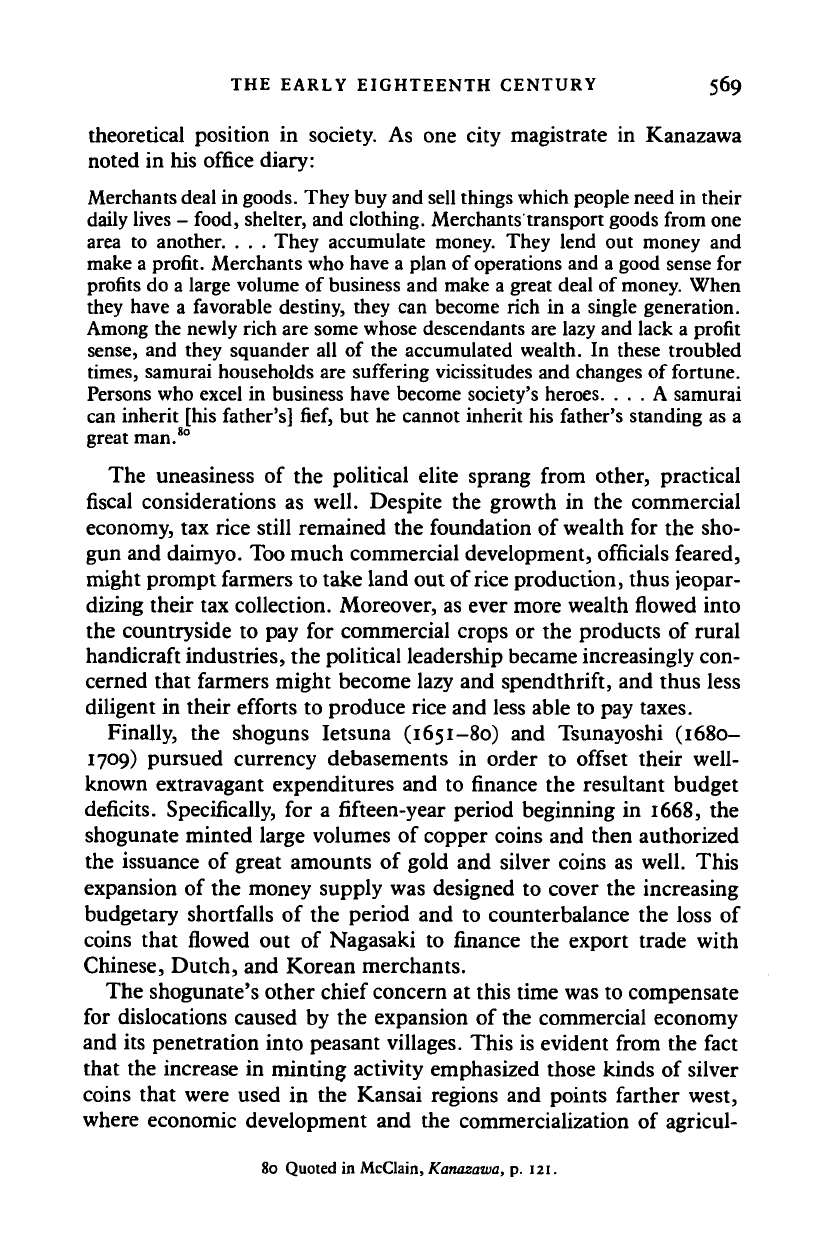
THE EARLY EIGHTEENTH CENTURY 569
theoretical position in society. As one city magistrate in Kanazawa
noted in his office diary:
Merchants deal in goods. They buy and sell things which people need in their
daily lives - food, shelter, and clothing. Merchants transport goods from one
area to another. . . . They accumulate money. They lend out money and
make a profit. Merchants who have a plan of operations and a good sense for
profits do a large volume of business and make a great deal of
money.
When
they have a favorable destiny, they can become rich in a single generation.
Among the newly rich are some whose descendants are lazy and lack a profit
sense, and they squander all of the accumulated wealth. In these troubled
times,
samurai households are suffering vicissitudes and changes of fortune.
Persons who excel in business have become society's heroes. ... A samurai
can inherit [his father's]
fief,
but he cannot inherit his father's standing as a
great man.
80
The uneasiness of the political elite sprang from other, practical
fiscal considerations as well. Despite the growth in the commercial
economy, tax rice still remained the foundation of wealth for the sho-
gun and daimyo. Too much commercial development, officials feared,
might prompt farmers to take land out of rice production, thus jeopar-
dizing their tax collection. Moreover, as ever more wealth flowed into
the countryside to pay for commercial crops or the products of rural
handicraft industries, the political leadership became increasingly con-
cerned that farmers might become lazy and spendthrift, and thus less
diligent in their efforts to produce rice and less able to pay taxes.
Finally, the shoguns Ietsuna (1651-80) and Tsunayoshi (1680-
1709) pursued currency debasements in order to offset their well-
known extravagant expenditures and to finance the resultant budget
deficits. Specifically, for a fifteen-year period beginning in 1668, the
shogunate minted large volumes of copper coins and then authorized
the issuance of great amounts of gold and silver coins as well. This
expansion of the money supply was designed to cover the increasing
budgetary shortfalls of the period and to counterbalance the loss of
coins that flowed out of Nagasaki to finance the export trade with
Chinese, Dutch, and Korean merchants.
The shogunate's other chief concern at this time was to compensate
for dislocations caused by the expansion of the commercial economy
and its penetration into peasant villages. This is evident from the fact
that the increase in minting activity emphasized those kinds of silver
coins that were used in the Kansai regions and points farther west,
where economic development and the commercialization of agricul-
80 Quoted in McClain, Kanazawa, p. 121.
Cambridge Histories Online © Cambridge University Press, 2008
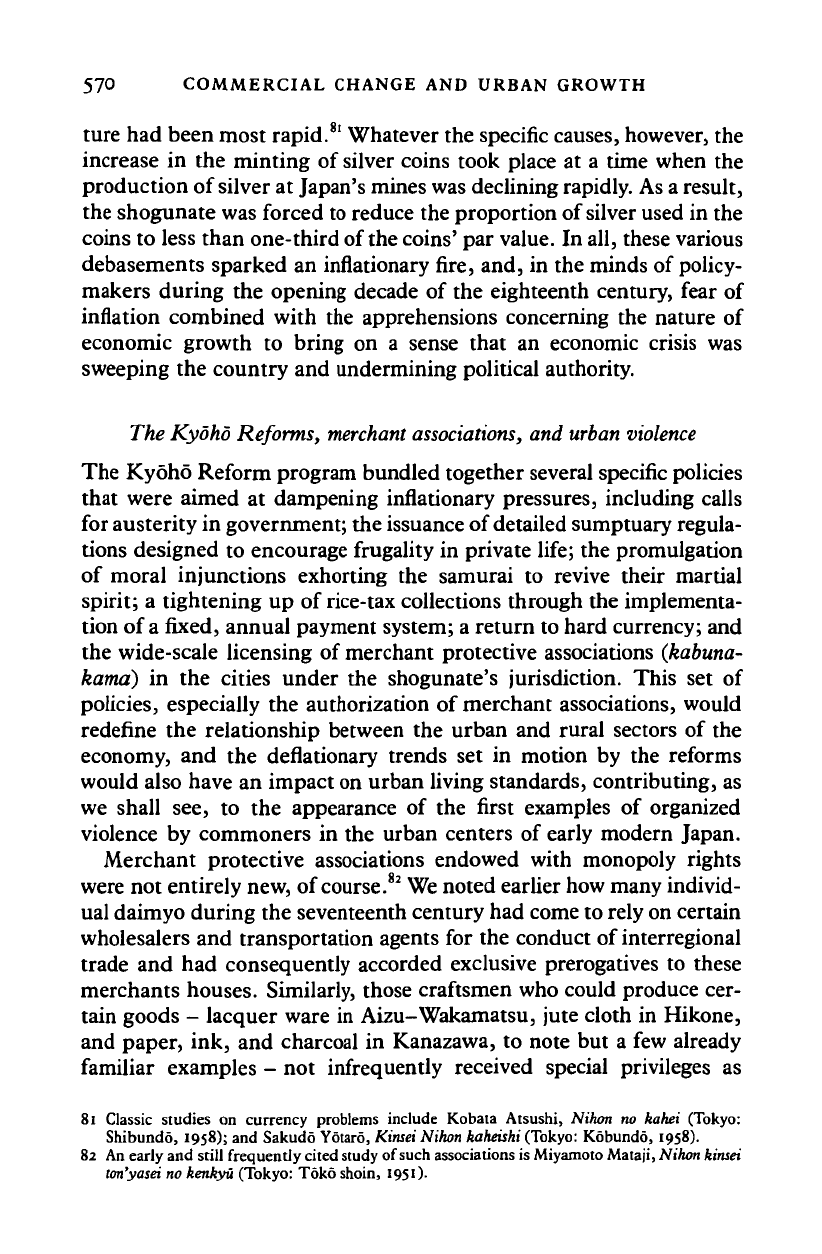
570 COMMERCIAL CHANGE AND URBAN GROWTH
ture had been most rapid.
81
Whatever the specific causes, however, the
increase in the minting of silver coins took place at a time when the
production of silver at Japan's mines was declining rapidly. As a result,
the shogunate was forced to reduce the proportion of silver used in the
coins to less than one-third of the coins' par value. In all, these various
debasements sparked an inflationary fire, and, in the minds of policy-
makers during the opening decade of the eighteenth century, fear of
inflation combined with the apprehensions concerning the nature of
economic growth to bring on a sense that an economic crisis was
sweeping the country and undermining political authority.
The Kyoho Reforms,
merchant
associations,
and urban violence
The Kyoho Reform program bundled together several specific policies
that were aimed at dampening inflationary pressures, including calls
for austerity in government; the issuance of detailed sumptuary regula-
tions designed to encourage frugality in private life; the promulgation
of moral injunctions exhorting the samurai to revive their martial
spirit; a tightening up of rice-tax collections through the implementa-
tion of
a
fixed, annual payment system; a return to hard currency; and
the wide-scale licensing of merchant protective associations (kabuna-
kama) in the cities under the shogunate's jurisdiction. This set of
policies, especially the authorization of merchant associations, would
redefine the relationship between the urban and rural sectors of the
economy, and the deflationary trends set in motion by the reforms
would also have an impact on urban living standards, contributing, as
we shall see, to the appearance of the first examples of organized
violence by commoners in the urban centers of early modern Japan.
Merchant protective associations endowed with monopoly rights
were not entirely new, of course.
82
We noted earlier how many individ-
ual daimyo during the seventeenth century had come to rely on certain
wholesalers and transportation agents for the conduct of interregional
trade and had consequently accorded exclusive prerogatives to these
merchants houses. Similarly, those craftsmen who could produce cer-
tain goods - lacquer ware in Aizu-Wakamatsu, jute cloth in Hikone,
and paper, ink, and charcoal in Kanazawa, to note but a few already
familiar examples - not infrequently received special privileges as
81 Classic studies on currency problems include Kobata Atsushi, Nihon no kahei (Tokyo:
Shibundo, 1958); and Sakudo Yotaro, Kinsei Nihon kaheishi (Tokyo: Kobundo, 1958).
82 An early and still frequently cited study of such associations is Miyamoto Mataji, Nihon
kinsei
ton'yasei no kenkyu (Tokyo: Toko shoin, 1951).
Cambridge Histories Online © Cambridge University Press, 2008
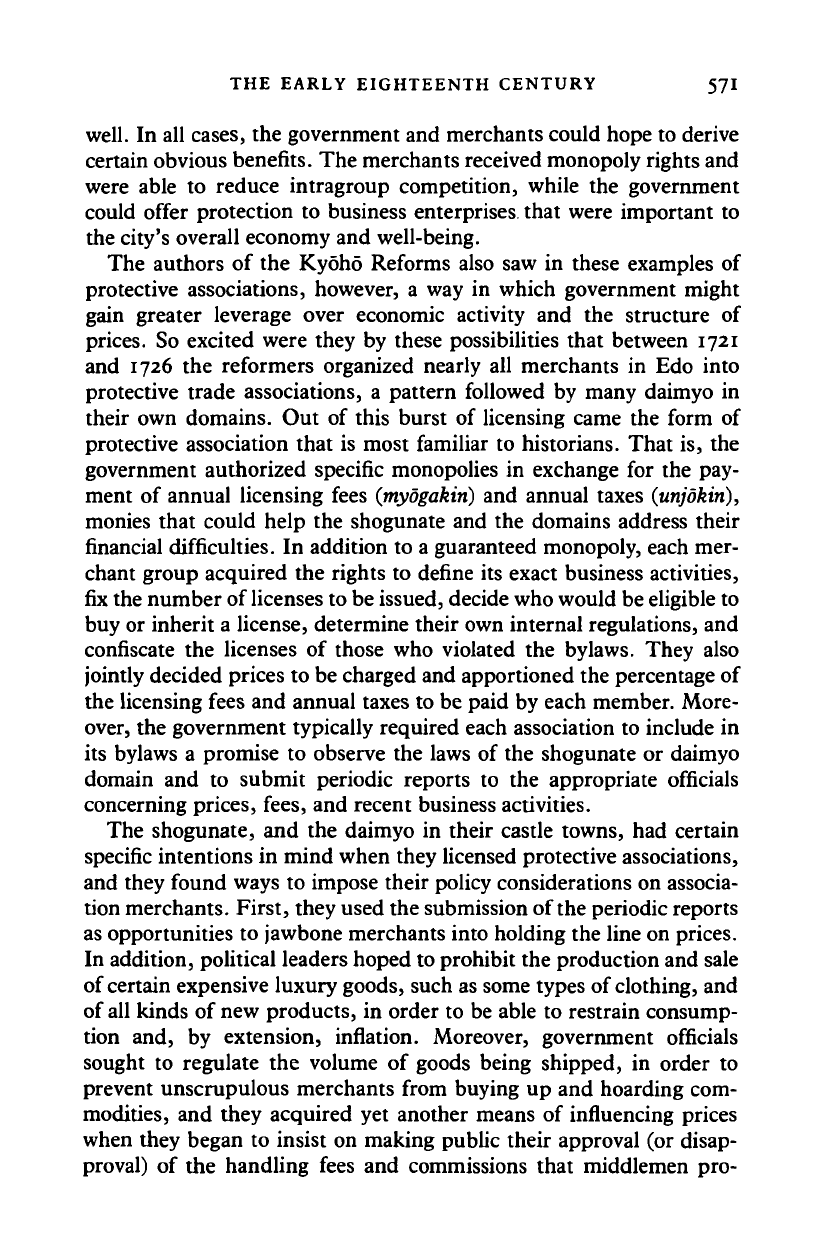
THE EARLY EIGHTEENTH CENTURY 571
well. In all cases, the government and merchants could hope to derive
certain obvious benefits. The merchants received monopoly rights and
were able to reduce intragroup competition, while the government
could offer protection to business enterprises that were important to
the city's overall economy and well-being.
The authors of the Kyoho Reforms also saw in these examples of
protective associations, however, a way in which government might
gain greater leverage over economic activity and the structure of
prices. So excited were they by these possibilities that between 1721
and 1726 the reformers organized nearly all merchants in Edo into
protective trade associations, a pattern followed by many daimyo in
their own domains. Out of this burst of licensing came the form of
protective association that is most familiar to historians. That is, the
government authorized specific monopolies in exchange for the pay-
ment of annual licensing fees
(myogakin)
and annual taxes (unjokin),
monies that could help the shogunate and the domains address their
financial difficulties. In addition to a guaranteed monopoly, each mer-
chant group acquired the rights to define its exact business activities,
fix the number of licenses to be issued, decide who would be eligible to
buy or inherit a license, determine their own internal regulations, and
confiscate the licenses of those who violated the bylaws. They also
jointly decided prices to be charged and apportioned the percentage of
the licensing fees and annual taxes to be paid by each member. More-
over, the government typically required each association to include in
its bylaws a promise to observe the laws of the shogunate or daimyo
domain and to submit periodic reports to the appropriate officials
concerning prices, fees, and recent business activities.
The shogunate, and the daimyo in their castle towns, had certain
specific intentions in mind when they licensed protective associations,
and they found ways to impose their policy considerations on associa-
tion merchants. First, they used the submission of
the
periodic reports
as opportunities to jawbone merchants into holding the line on prices.
In addition, political leaders hoped to prohibit the production and sale
of certain expensive luxury goods, such as some types of
clothing,
and
of all kinds of new products, in order to be able to restrain consump-
tion and, by extension, inflation. Moreover, government officials
sought to regulate the volume of goods being shipped, in order to
prevent unscrupulous merchants from buying up and hoarding com-
modities, and they acquired yet another means of influencing prices
when they began to insist on making public their approval (or disap-
proval) of the handling fees and commissions that middlemen pro-
Cambridge Histories Online © Cambridge University Press, 2008
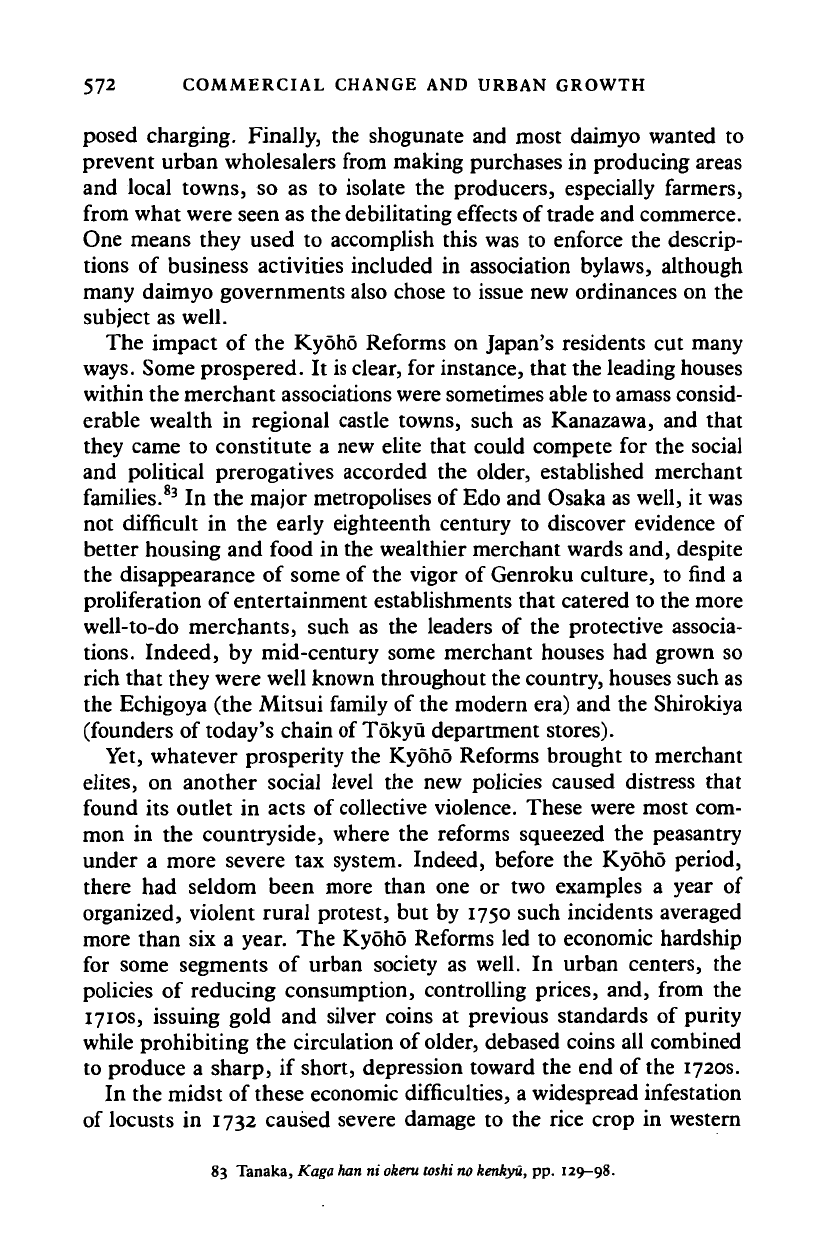
572 COMMERCIAL CHANGE AND URBAN GROWTH
posed charging. Finally, the shogunate and most daimyo wanted to
prevent urban wholesalers from making purchases in producing areas
and local towns, so as to isolate the producers, especially farmers,
from what were seen as the debilitating effects of trade and commerce.
One means they used to accomplish this was to enforce the descrip-
tions of business activities included in association bylaws, although
many daimyo governments also chose to issue new ordinances on the
subject as well.
The impact of the Kyoho Reforms on Japan's residents cut many
ways.
Some prospered. It is clear, for instance, that the leading houses
within the merchant associations were sometimes able to amass consid-
erable wealth in regional castle towns, such as Kanazawa, and that
they came to constitute a new elite that could compete for the social
and political prerogatives accorded the older, established merchant
families.
83
In the major metropolises of Edo and Osaka as well, it was
not difficult in the early eighteenth century to discover evidence of
better housing and food in the wealthier merchant wards and, despite
the disappearance of some of the vigor of Genroku culture, to find a
proliferation of entertainment establishments that catered to the more
well-to-do merchants, such as the leaders of the protective associa-
tions.
Indeed, by mid-century some merchant houses had grown so
rich that they were well known throughout the country, houses such as
the Echigoya (the Mitsui family of the modern era) and the Shirokiya
(founders of today's chain of Tokyu department stores).
Yet, whatever prosperity the Kyoho Reforms brought to merchant
elites,
on another social level the new policies caused distress that
found its outlet in acts of collective violence. These were most com-
mon in the countryside, where the reforms squeezed the peasantry
under a more severe tax system. Indeed, before the Kyoho period,
there had seldom been more than one or two examples a year of
organized, violent rural protest, but by 1750 such incidents averaged
more than six a year. The Kyoho Reforms led to economic hardship
for some segments of urban society as well. In urban centers, the
policies of reducing consumption, controlling prices, and, from the
1710s, issuing gold and silver coins at previous standards of purity
while prohibiting the circulation of older, debased coins all combined
to produce a sharp, if short, depression toward the end of the 1720s.
In the midst of these economic difficulties, a widespread infestation
of locusts in 1732 caused severe damage to the rice crop in western
83 Tanaka, Kaga
han
ni
okeru toshi no
kenkyu,
pp. 129-98.
Cambridge Histories Online © Cambridge University Press, 2008
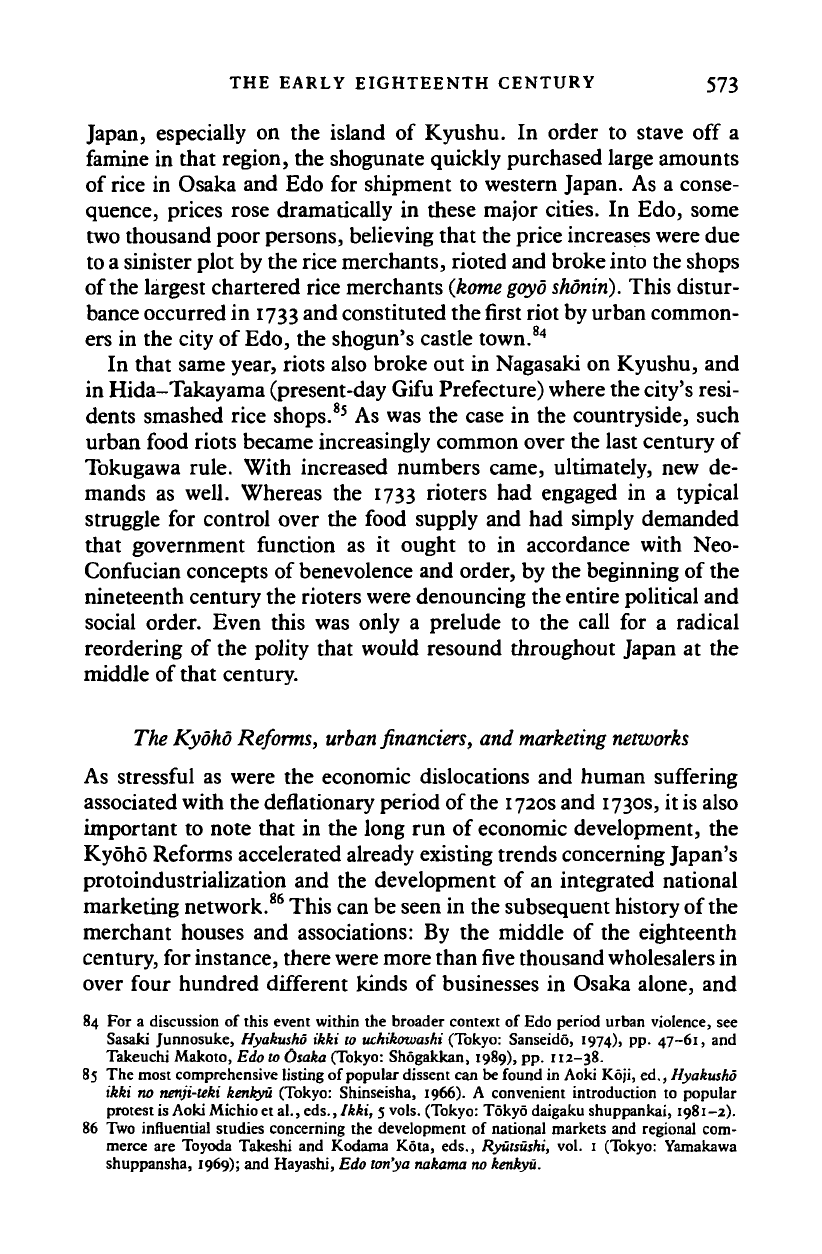
THE EARLY EIGHTEENTH CENTURY 573
Japan, especially on the island of Kyushu. In order to stave off a
famine in that region, the shogunate quickly purchased large amounts
of rice in Osaka and Edo for shipment to western Japan. As a conse-
quence, prices rose dramatically in these major cities. In Edo, some
two thousand poor persons, believing that the price increases were due
to a sinister plot by the rice merchants, rioted and broke into the shops
of
the
largest chartered rice merchants
(koine goyo
shdnin).
This distur-
bance occurred in
1733
and constituted the first riot by urban common-
ers in the city of
Edo,
the shogun's castle town.
84
In that same year, riots also broke out in Nagasaki on Kyushu, and
in Hida-Takayama (present-day Gifu Prefecture) where the city's resi-
dents smashed rice shops.
85
As was the case in the countryside, such
urban food riots became increasingly common over the last century of
Tokugawa rule. With increased numbers came, ultimately, new de-
mands as well. Whereas the 1733 rioters had engaged in a typical
struggle for control over the food supply and had simply demanded
that government function as it ought to in accordance with Neo-
Confucian concepts of benevolence and order, by the beginning of the
nineteenth century the rioters were denouncing the entire political and
social order. Even this was only a prelude to the call for a radical
reordering of the polity that would resound throughout Japan at the
middle of that century.
The Kyoho Reforms, urban financiers, and marketing networks
As stressful as were the economic dislocations and human suffering
associated with the deflationary period of the 1720s and 1730s, it
is
also
important to note that in the long run of economic development, the
Kyoho Reforms accelerated already existing trends concerning Japan's
protoindustrialization and the development of an integrated national
marketing network.
86
This can be seen in the subsequent history of the
merchant houses and associations: By the middle of the eighteenth
century, for instance, there
were
more than
five
thousand wholesalers in
over four hundred different kinds of businesses in Osaka alone, and
84 For a discussion of this event within the broader context of Edo period urban violence, see
Sasaki Junnosuke, Hyakusho ikki to uchikowashi (Tokyo: Sanseido, 1974), pp.
47-61,
and
Takeuchi Makoto, Edo to Osaka (Tokyo: Shogakkan, 1989), pp. 112-38.
85 The most comprehensive listing of popular dissent can be found in Aoki Koji, ed., Hyakusho
ikki no nenji-teki kenkyu (Tokyo: Shinseisha, 1966). A convenient introduction to popular
protest is Aoki Michio et al., eds., Ikki, 5 vols. (Tokyo: Tokyo daigaku shuppankai, 1981-2).
86 Two influential studies concerning the development of national markets and regional com-
merce are Toyoda Takeshi and Kodama Kota, eds., Ryutsushi, vol. 1 (Tokyo: Yamakawa
shuppansha, 1969); and Hayashi, Edo ton'ya nakama no kenkyu.
Cambridge Histories Online © Cambridge University Press, 2008
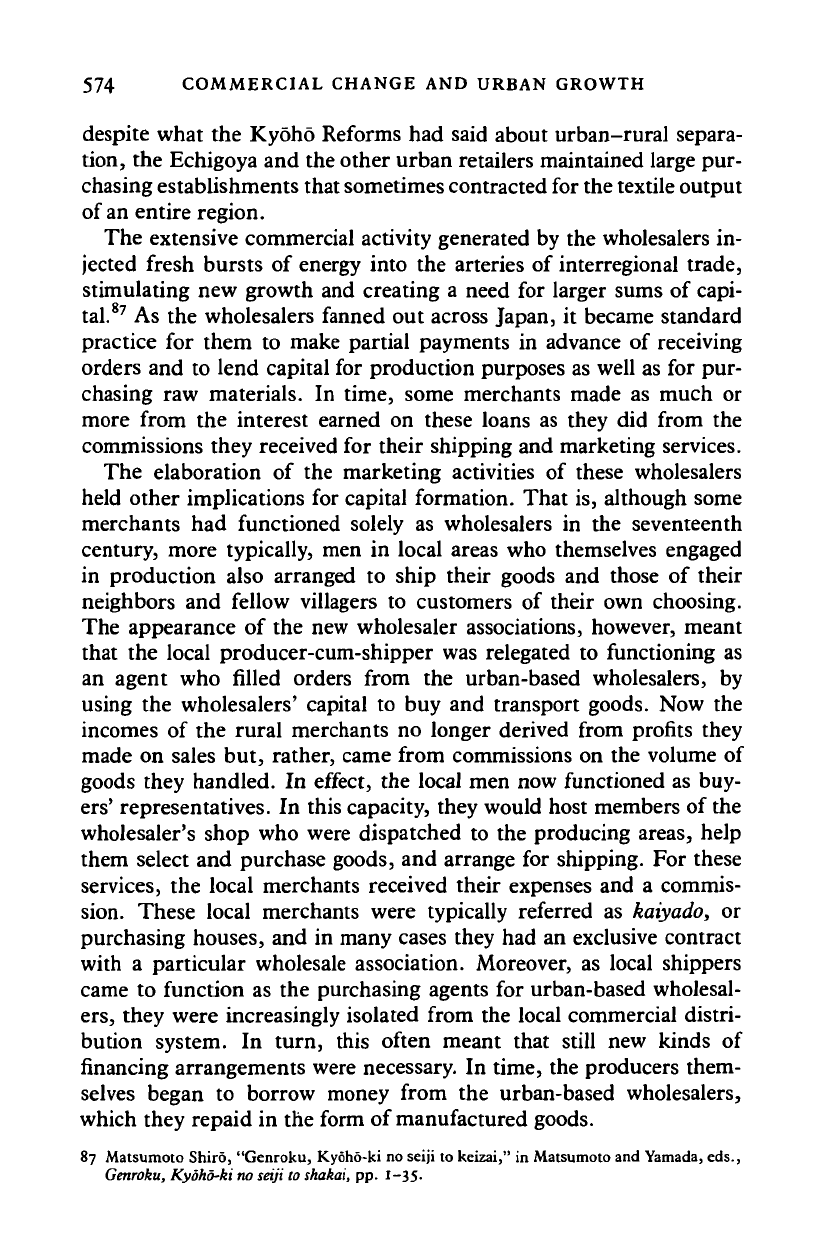
574 COMMERCIAL CHANGE AND URBAN GROWTH
despite what the Kyoho Reforms had said about urban-rural separa-
tion, the Echigoya and the other urban retailers maintained large pur-
chasing establishments that sometimes contracted for the textile output
of an entire region.
The extensive commercial activity generated by the wholesalers in-
jected fresh bursts of energy into the arteries of interregional trade,
stimulating new growth and creating a need for larger sums of capi-
tal.
87
As the wholesalers fanned out across Japan, it became standard
practice for them to make partial payments in advance of receiving
orders and to lend capital for production purposes as well as for pur-
chasing raw materials. In time, some merchants made as much or
more from the interest earned on these loans as they did from the
commissions they received for their shipping and marketing services.
The elaboration of the marketing activities of these wholesalers
held other implications for capital formation. That is, although some
merchants had functioned solely as wholesalers in the seventeenth
century, more typically, men in local areas who themselves engaged
in production also arranged to ship their goods and those of their
neighbors and fellow villagers to customers of their own choosing.
The appearance of the new wholesaler associations, however, meant
that the local producer-cum-shipper was relegated to functioning as
an agent who filled orders from the urban-based wholesalers, by
using the wholesalers' capital to buy and transport goods. Now the
incomes of the rural merchants no longer derived from profits they
made on sales but, rather, came from commissions on the volume of
goods they handled. In effect, the local men now functioned as buy-
ers'
representatives. In this capacity, they would host members of the
wholesaler's shop who were dispatched to the producing areas, help
them select and purchase goods, and arrange for shipping. For these
services, the local merchants received their expenses and a commis-
sion. These local merchants were typically referred as kaiyado, or
purchasing houses, and in many cases they had an exclusive contract
with a particular wholesale association. Moreover, as local shippers
came to function as the purchasing agents for urban-based wholesal-
ers,
they were increasingly isolated from the local commercial distri-
bution system. In turn, this often meant that still new kinds of
financing arrangements were necessary. In time, the producers them-
selves began to borrow money from the urban-based wholesalers,
which they repaid in the form of manufactured goods.
87 Matsumoto Shiro, "Genroku, Kyoho-ki no seiji to keizai," in Matsumoto and Yamada, eds.,
Genroku, Kyoho-ki no seiji to shakai, pp. 1-35.
Cambridge Histories Online © Cambridge University Press, 2008
